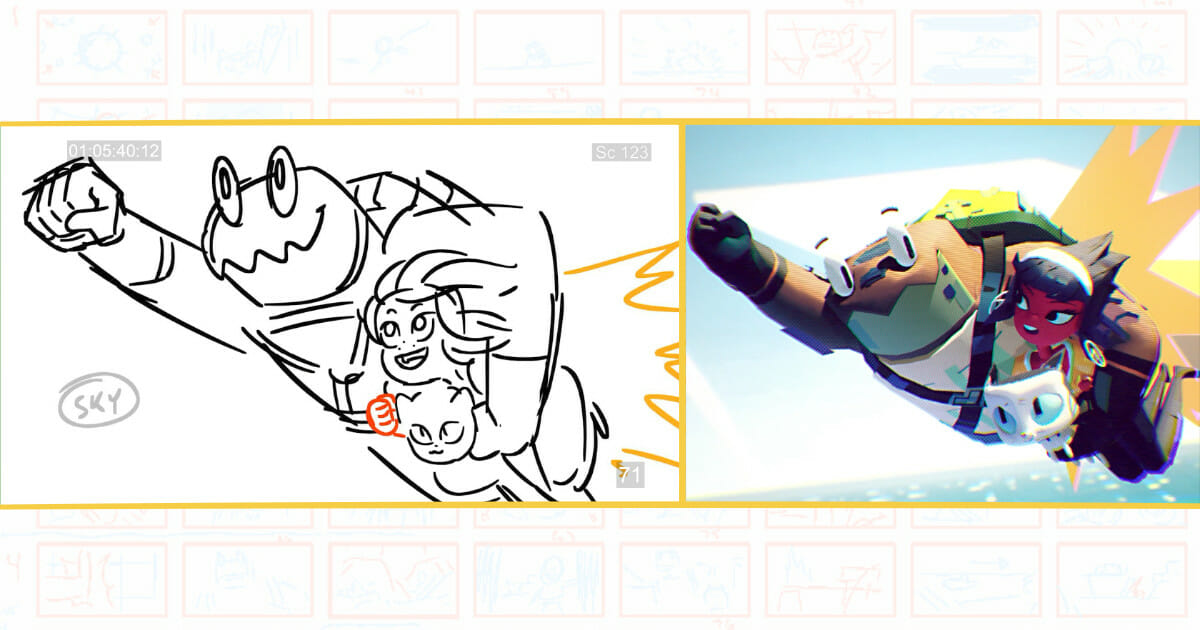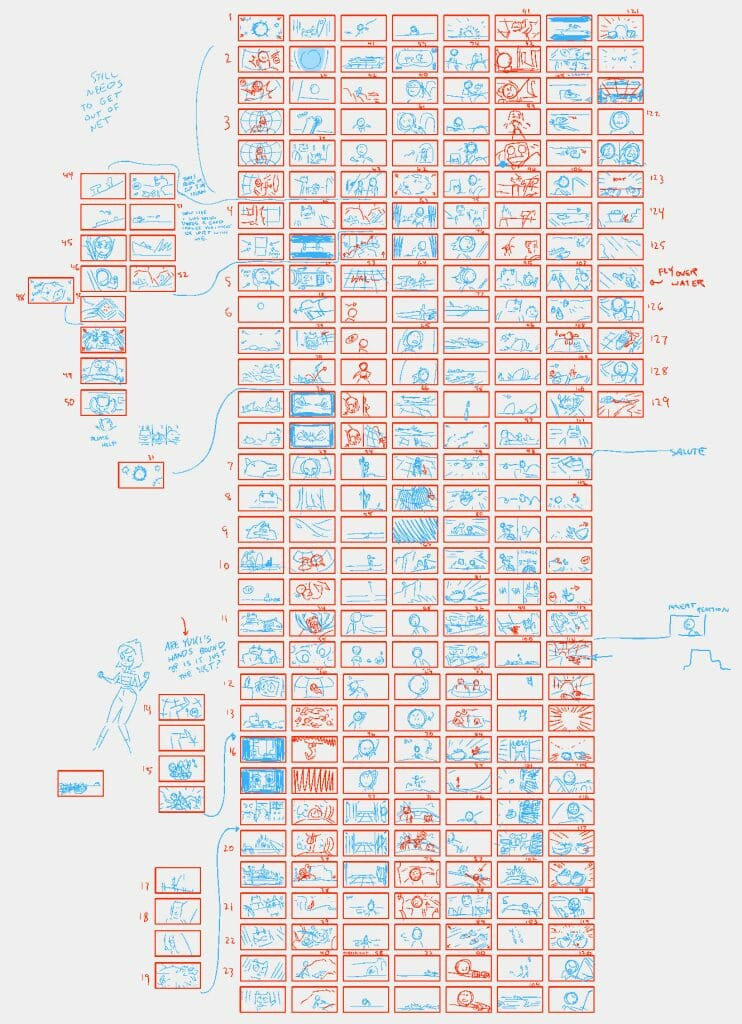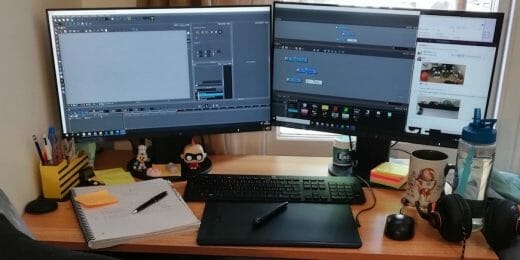
YUKI 7 is an animated mini-series that stars super-spy Yuki 7, her talking cat, and a rocket-powered turtle man. Together, Yuki and her crew go on thrilling adventures that bring them to various international locations. The series’ three episodes premiered online on August 26th.
This action-packed webseries is an independent production, dreamed up by Kevin Dart and created by the assembled team at Chromosphere. The small studio is known for experimenting with techniques, and it shows in YUKI 7. The series was storyboarded using Storyboard Pro, and features hybrid, hyper-stylized 2D-mixed-with-3D animation. The resulting aesthetic leans heavily on vintage and retro inspiration, instantly familiar to anyone with fond memories of the PlayStation-era.
We caught up with Kevin Dart and storyboard artist Dashawn Mahone to learn more about what inspired the series, and how it all came together. Kevin outlines the techniques used in the project, and how the studio integrated 3D and 2D animation, while Dashawn shares his approach to storyboarding. Read on for a complete mission briefing about YUKI 7!
What is the background of Chromosphere and what kind of work does the studio do?
Kevin: Chromosphere is a small design animation studio. I started it in 2016, after working in animation for several years as a designer and art director. We do a variety of work from commercials to design for TV series. And, we work on our own projects, like YUKI 7. Chromosphere has a really varied group of people doing different things, and all in a small space.
I think what makes our studio unique is that we are open to different and unusual types of projects. We’re especially interested in projects that use new or emerging technology.
Chromosphere is known as a creative harbor where unconventional ideas can grow. How do you foster this sort of approach in the studio?
Kevin: From working in animation for several years, I’m well aware of the limitations you can run into when working on a project. There are always creative and practical hurdles that you’ll encounter. I wanted to create a space where artists could focus mainly on the art, and be able to pursue ideas without being concerned about these hurdles, or about failing.
Of course, with this approach it can sometimes be a challenge to convince people to pay us to try new ideas, but it’s worth it! The way we’ve fostered our approach has been mainly through trusting our artists. We give them a lot of space to just do their thing.

Tell me about YUKI 7. What is the microseries about?
Kevin: YUKI 7 is an original concept that Chromosphere came up with. It’s an action, adventure, and comedy series that revolves around an imaginary world with characters that we all really enjoy. YUKI 7 is a playground for us. It’s a creative outlet for us to do whatever we want with, both creatively and technically. We are able to craft the story and characters however we like, but we’re also able to experiment with different techniques. For example, we’ve mixed 2D and 3D, and tried VR in the series.
YUKI 7 is truly a passion project, as well as the biggest project Chromosphere is working on — with the least amount of limitations.
What inspired the story behind Yuki and her team of sidekicks?
Kevin: Yuki is based on a character that I’ve been tinkering with since around 2008. She was originally inspired by my wife, Elizabeth Ito. (Creator of the Netflix series, City of Ghosts.) When I met Elizabeth, I was so impressed by her ability to fight the odds, and go out into the world and kick butt. It was Elizabeth’s personality that inspired the original Yuki, all those years ago. I then combined the idea of Yuki with other things I was inspired by, like spy movies, and old sci-fi TV shows. Over time, Yuki’s character and the world around it has evolved.
In the earlier iterations of Yuki, it was just her being out there, being cool. Eventually we realized that it would be fun to create a rag-tag group of sidekicks for her. We created Rocket Turtle, who has bits of personality that I relate to. Rocket Turtle is always trying to keep up with what Yuki is doing in a kind of blockheaded way. And Goldpaws was inspired by my love of cats!

You mentioned that you’ve been able to experiment with different techniques in making YUKI 7. What was the most exciting technique that you got to use in the series?
Kevin: In the third episode of YUKI 7, we worked with Unreal Engine. It’s a real-time 3D creation tool that is used to make many games, like Fortnite. Because Unreal is a very comprehensive engine, people are now using it for animation and visual effects.
We applied for a grant to use Unreal when we were already mid production. We got the grant, and so it went towards making episode 3. Creating an episode with Unreal is a very different pipeline. It felt like we were building a live-action scene, like you would on a set.
The series has a retro look to it. Is there anywhere specific that you drew inspiration from for this style?
Kevin: We definitely wanted the series to have a 1970s, sci-fi look to it. We drew inspiration from The Prisoner, The Six Million Dollar Man, and Jackie Chan films. Those were some of the main references, but aside from that, every artist contributed their own style and inspiration to the series. We encourage our artists to put themselves into our projects, and so ultimately, YUKI 7 is the product of a huge mix of influences, references, and inspiration.
How did you achieve this aesthetic?
Kevin: The first step was bringing Dashawn on. Early in the project, he boarded the first big chase scene, which takes place in Hong Kong, in episode one. His first crack at storyboarding this scene really did guide the look of the show. The way he posed the characters, the camera angles, staging, and the use of splitscreens, all of that originated from Dashawn’s first storyboards.
Some of the aesthetic came from our approach to CG. We aren’t a CG studio, so we took a purposefully low tech and imprecise approach to the use of 3D in this series. We did lots of experimentation in Quill to see if we could make the 3D look sketchy and imperfect. Usually if you’re working in 3D, you want the model to be fancy. That wasn’t at all our goal, we didn’t want the CG to function in the way viewers expect it to. And, we added CRT patterns to try to make it feel like you’re watching something that’s been spat out of an old television set.
#YUKI7 ?️Storyboards ➡️ Animation ?️!!
— Chromosphere (@chromosphereLA) September 1, 2021
See how @dashawnmahone planned out the action for Episode 1’s big chase in Hong Kong!
Watch Episode 1 ⏩ https://t.co/A1rJzP74y1 pic.twitter.com/LY0sRbgQJf
YUKI 7 was boarded in Storyboard Pro. What was the process of storyboarding this project?
Dashawn: My approach to storyboarding was a pretty standard one. Before I got started on boarding that first chase scene in Hong Kong, Kevin provided examples of TV shows and movies for me to look at to get inspiration. I knew a lot of the references already because our tastes happened to align, but there were a couple I hadn’t seen. So I spent some time studying those references. I started by working on thumbnails shortly after, which I presented to Kevin and the rest of the team before boarding further. I was pretty nervous to show them what I had done, but they were totally happy with it!
Kevin: Seeing how Dashawn was bringing the concept and story to life was so exciting. The thumbnails were everything I had hoped for and more. As soon as I saw those first thumbnails, I knew we absolutely had to follow through with making the series. Dashawn boarded that first Hong Kong sequence — but months later when we were ready to work more on the series, he was busy with other projects.
So we worked with a couple other storyboarders. Michael Yates did some, and Jessie Wong came on and boarded the scene where Yuki is getting ready to launch off on her mission to Tangier. In making YUKI 7 we had to juggle and balance people’s different availabilities, and based on the funding we had available. This is pretty typical for indie productions.
Time for another #YUKI7 ?️ Storyboards ➡️ Animation ?️ Video!!
— Chromosphere (@chromosphereLA) September 21, 2021
Check out how @jessiewongg boarded Yuki’s meticulous packing techniques in this fun sequence from Episode 2!
Watch Episode 2 ⏩ https://t.co/ZsGHCrxU9q pic.twitter.com/06fwAJz0Up
Do you have any advice for artists interested in working on independent projects, like YUKI 7?
Kevin: At Chromosphere we’ve noticed that we can really sense when people have the same creative sleeplessness that we have. For indie projects like YUKI 7, it’s important to have passion and a genuine desire to work on a project. We often find artists to work with through their personal projects, because those show that the artist has passion and a drive to do cool things.
Dashawn: Exactly. That’s how I ended up working on YUKI 7. Kevin found me through my webcomic, Valorous Tales, which was pretty awesome since I hadn’t worked on that project in a while. Now I am working on another personal project, a graphic novel called The Brothers Boom. Having personal projects is a really good way to express yourself and your voice. It’s fun to work on your own stuff, but it can also lead to work on other projects, like indie productions.
Interested in seeing more of YUKI 7’s missions? You can find the entire microseries on YouTube. Ready to storyboard your independent animated project? Download Storyboard Pro and see how far you can get during the free 21-day trial.



